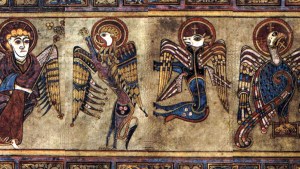Lenten Campaign 2025
This content is free of charge, as are all our articles.
Support us with a donation that is tax-deductible and enable us to continue to reach millions of readers.
Genesis 2:10-14 describes an unnamed stream flowing out of the Garden of Eden, dividing into four branches. Unlike the main torrent, these four tributary streams do have names. They are known as Pishon, Gihon, Hiddekel (Tigris), and Phrath (Euphrates). As is often the case with topographical references in Scripture, these rivers are not merely geographical features. They carry heavy symbolic weight and have thus been studied from theological, ethical, philosophical, and spiritual standpoints. Needless to say, Christian iconography echoes this long tradition of commentary.
The interpretation of the four rivers took a significant turn through the teachings of St. Ambrose, dating back to the 4th century. In his writings, these rivers became emblematic of the four Gospels – this being the reason why most Byzantine mosaics depicting these rivers include the Tetramorphos. According to this perspective, the Water of Life flows from the word of Christ, identified as the Fountain of Life. This symbolism was profusely represented not only in mosaics but also in manuscripts.
As theological commentary grew, the association between the rivers and the evangelists became even more nuanced. By the 11th century, Gihon personified Matthew, Tigris represented Mark, Euphrates was linked with Luke, and Pishon aligned with John. Specific qualities were attributed to each river, adding layers of meaning to the narrative.
The rivers of Paradise found a prominent place in Christian art during the 4th to 6th centuries, continuing into the medieval era, especially during the Carolingian period. Artists depicted these sacred waters in various allegorical contexts, often flowing underneath the feet of Christ, emanating from His throne, or even referring to the blood and water running from the wound on his side – especially in Eastern traditions.
The visual representation frequently included two stags drinking from the streams, a poignant reference to Psalm 42: As a deer longs for flowing streams, so my soul longs for you, O God.



